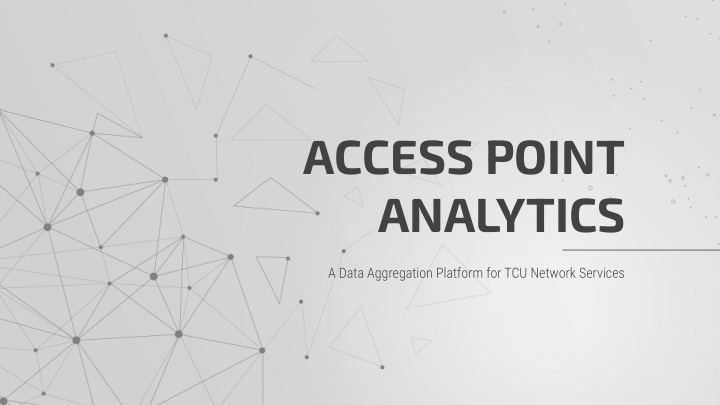



ACCESS POINT ANALYTICS A Data Aggregation Platform for TCU Network Services
THE TEAM JUSTIS HUNG RYAN MATT BRADLEY CLARK DOAN FINNEGAN LIDDY SCHOENEWEIS Project Manager & Developer Developer Data Scientist & Technical Lead & Developer Developer Developer
INTRODUCTION & BACKGROUND 01 Access Points & Key Performance Indicators THE PROJECT 02 Requirements & Vision PROJECT DEMO 04 OUTLINE The Web Application In Action THE SOLUTION 03 A High-Level View of the System RETROSPECT 05 Reviewing the Process & Lessons Learned QUESTION & ANSWER 06 Concluding Thoughts
01 Introduction & Background Access Points and Key Performance Indicators
ACCESS POINTS ACCESS POINTS - +3,200 Access Points (APs) across the TCU campus - Data Aggregated into Cisco Prime
THE CLIENTS & THE ISSUE - Overwhelming Data in Cisco Prime - Long Response & Remedy Times OVERWHELMING DATA CRAIG BAUGH TONY FLEMING
KEY PERFORMANCE INDICATORS (KPIs) CHANNEL ANOMALY ACCESS POINT CLIENT UTILIZATION DETECTION UTILIZATION COUNT COVERAGE POWER/CHANNEL ROGUE ACCESS HOLES UTILIZATION POINTS
02 THE PROJECT Requirements & Vision
REQUIREMENTS USABILITY All-In-One Dashboard View Customization WEB APPLICATION MAINTAINABLE FUNCTIONALITY .NET Core based Isolated VM Web Application Environment written in C# Data Snapshots
THE VISION Our platform aims to provide proactive and reactive insights to TCU Network Services that are summarized, and actionable. These snapshot insights will be extracted from the massive data stream collected by wireless Access Points all over TCU's campus, and then presented through an internal Web-Application Interface.
03 THE SOLUTION A High-Level View of the System
SOLUTION FOCUSES Gather and filter pertinent information for each KPI, while simultaneously performing calculations in real-time to keep the data true and reusable AUTOMATION CONSOLIDATION SIMPLIFICATION Automatically ingest, analyze, and Present the data to the user through clean data related to the KPIs on information rich tables and clean data an adjustable schedule visualizations
PROCESS OVERVIEW CISCO SFTP DATA WEB PRIME SERVER ANALYSIS APPLICATION
SYSTEM ARCHITECTURE
TECHNOLOGY STACK C# .NET Core Cisco Prime GitLab MySQL JavaScript
04 PROJECT DEMO The Web Application In Action
DEMO OUTLINE 1 The Dashboard 2 The KPI Pages 3 The User System
DEMO - DASHBOARD OVERVIEW
DEMO - ANOMALY DETECTION
QUICK VIEW - ACCESS POINT UTILIZATION
QUICK VIEW - CHANNEL UTILIZATION
DEMO - CLIENT COUNT
DEMO - COVERAGE HOLES
QUICK VIEW - POWER/CHANNEL FLUCTUATION
DEMO - ROGUE ACCESS POINTS
QUICK VIEW - USER MANAGEMENT
QUICK VIEW - USER SETTINGS
05 RETROSPECT Reviewing the Process & Lessons Learned
TIMELINE HIGHLIGHTS FIRST SEMESTER Tech stack + system User system design finalized, functionality, UI/UX development environment improvements, set up schema overhaul SEP NOV AUG OCT DEC First meeting with all First KPI page with KPI schemas/list of the stakeholders arbitrary data, base finalized, aggregation present, system data imports and scalability planning complete improvements
TIMELINE HIGHLIGHTS SECOND SEMESTER Ingestion scripts System finalization, complete, second unit and acceptance KPI complete testing FEB APR JAN MAR System architecture Remaining KPIs refactor for completed, portability, dashboard complete, increased user Anomaly Detection functionality complete
PROJECT TAKEAWAYS TECHNOLOGIES BEST PRACTICES .NET Core System design C# Coding principles JavaScript/jQuery Documentation Git Testing SOFT SKILLS LESSONS LEARNED Time management Communication can be difficult Adaptability Strategic delegation Communication Visibility of work is key
THE FUTURE - Transfer over to a TCU development team - Deployment on a production server - Ever-improving Anomaly Detection
06 QUESTION & ANSWER Concluding Thoughts
ACKNOWLEDGEMENTS Our team would like to thank TCU Network Services, specifically Craig Baugh and Tony Fleming for letting us be creative and giving us the opportunity to develop this Web-Application. We’d also like to thank Dr. Bingyang Wei for his dedication to our class and our team, even through the unorthodox final semester we’ve had, and the COSC & CITE Faculty for supporting us these past 4 years.
THANK YOU! CREDITS: This presentation template was created by Slidesgo , including icons by Flaticon , and infographics & images by Freepik . Please keep this slide for attribution.
Recommend
More recommend